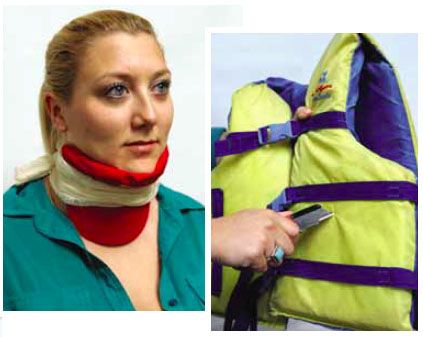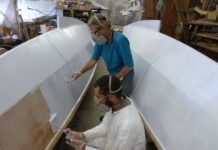
If you reach for the onboard first-aid kit and find out there isn’t one, don’t panic during an emergency. Some out-of-the-box thinking will help put the needed medical tools in your hands.
The guiding rule to survival is to use what’s available and improvise.
- Battens make ideal arm and leg splints. A rolled magazine can become both a splint and temporary cast, particularly when fastened snuggly with duct tape.
- Popsicle sticks make good finger splints.
- A towel cut into a triangular shape is a sling.
- Rolled towels can substitute for the foam blocks used to secure a patient’s head to a long spine board before transfer to a stretcher and ambulance.
- A belt is a tourniquet, as is a cloth sail tie or piece of webbing, both far better than twine or thin-diameter line that might cut into the skin when tightened. Be careful not to stop blood circulation completely or for longer than necessary.
- An eye injury can be covered and protected with a paper cup. Duct tape can be used to keep the cup in place.
- A baseball cap, the top material collapsed against the inside of the front insignia panel, can serve as a rudimentary cervical collar when tucked upside down beneath the chin. It can be fastened with duct tape or tied with a piece of fabric.
- A sail, especially a clean one, provides a warm and comfortable wrap for patients suffering from hypothermia.
- Aluminum foil works wonders when trying to keep a patient warm. It also can be used as a bandage cover.
- Clear plastic wrap can cover a sucking chest wound. Tape it on three sides.
- A clear plastic bag can shroud an injured hand or foot.
- Fresh water sterilized by boiling can be used to flush wounds.
- A turkey baster makes a wonderful syringe for irrigating a laceration.
- Bunk sheets can be folded into compress bandages.
- Napkins can be cut into small wound dressings similar to gauze pads.
- A plastic credit card can be used to brush off a bee’s stinger or nettles.
- For sailors with emergency medical experience, a cockpit winch and a length of webbing can be carefully implemented as a mechanical traction device for femur fractures.
- Sanitary napkins like Kotex make for absorbent wound dressings, while tampons can be used on nosebleeds or injuries with minor blood flow.
- Tea bags will sop up blood in a mouth injury.
- Fresh oranges can provide vitamin C. No glucose on board? Orange juice and sugar packets can assist in case of a diabetic reaction.
- And last, but not least, rum can be both painkiller and anesthetic.
— David Liscio, a Practical Sailor contributor, is a Massachusetts Emergency Medical Responder and certified Emergency Medical Technician.


































